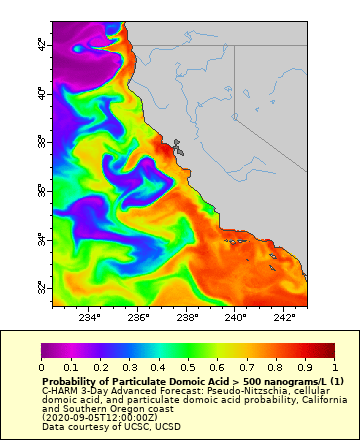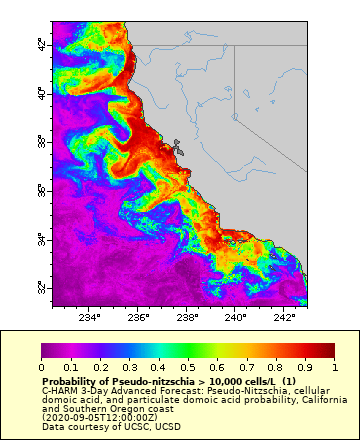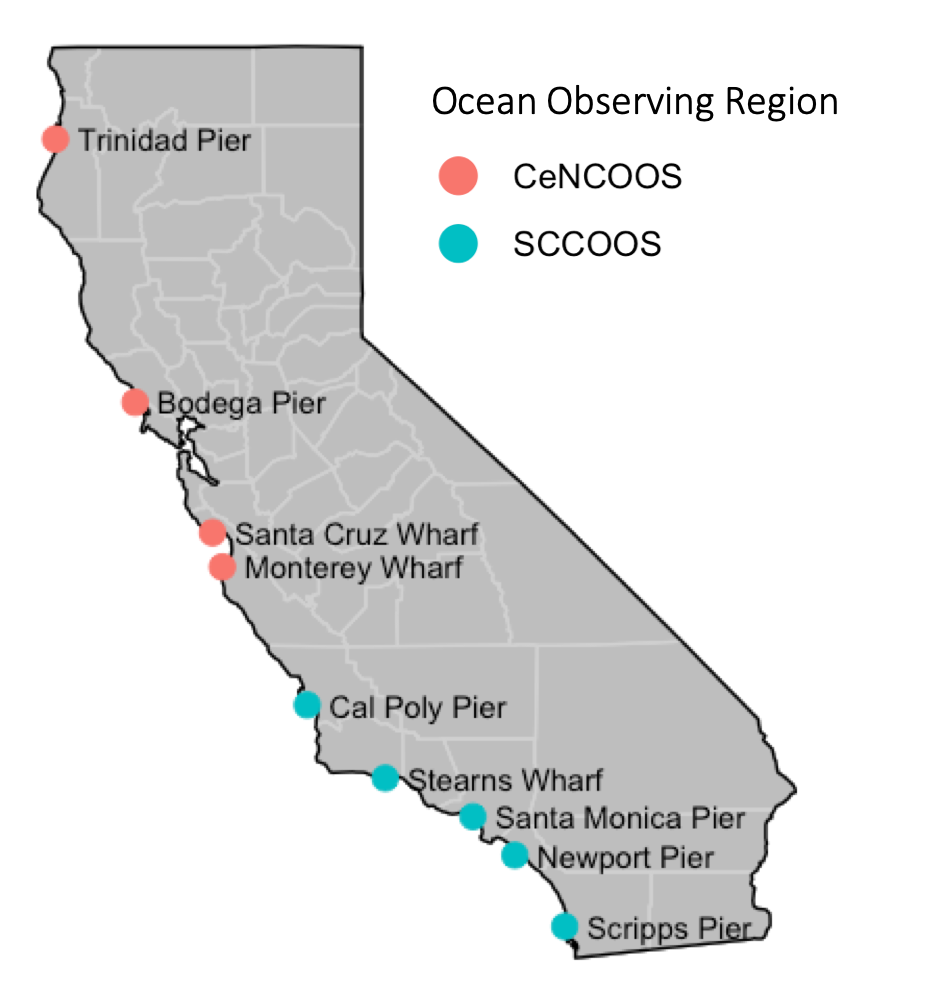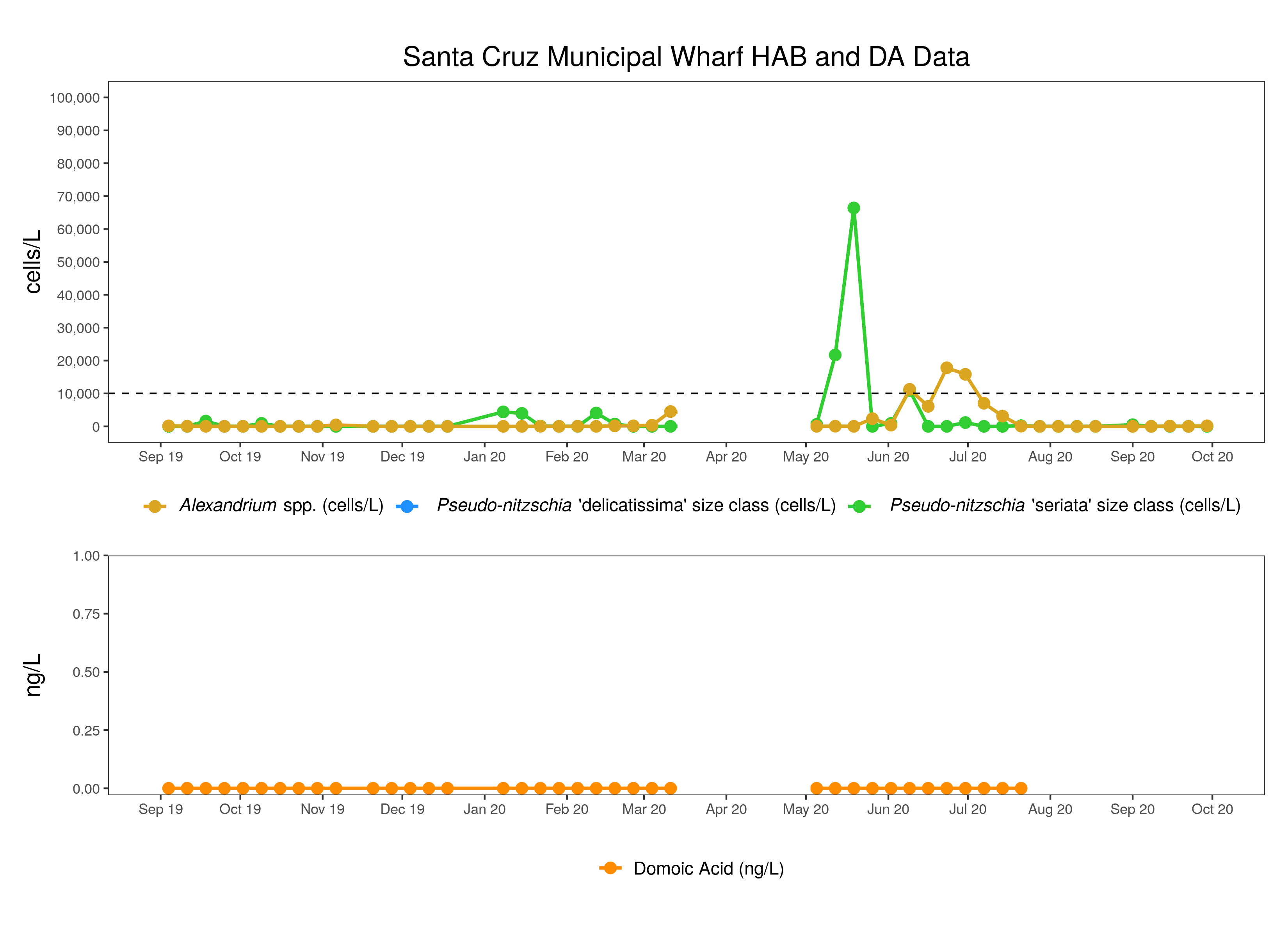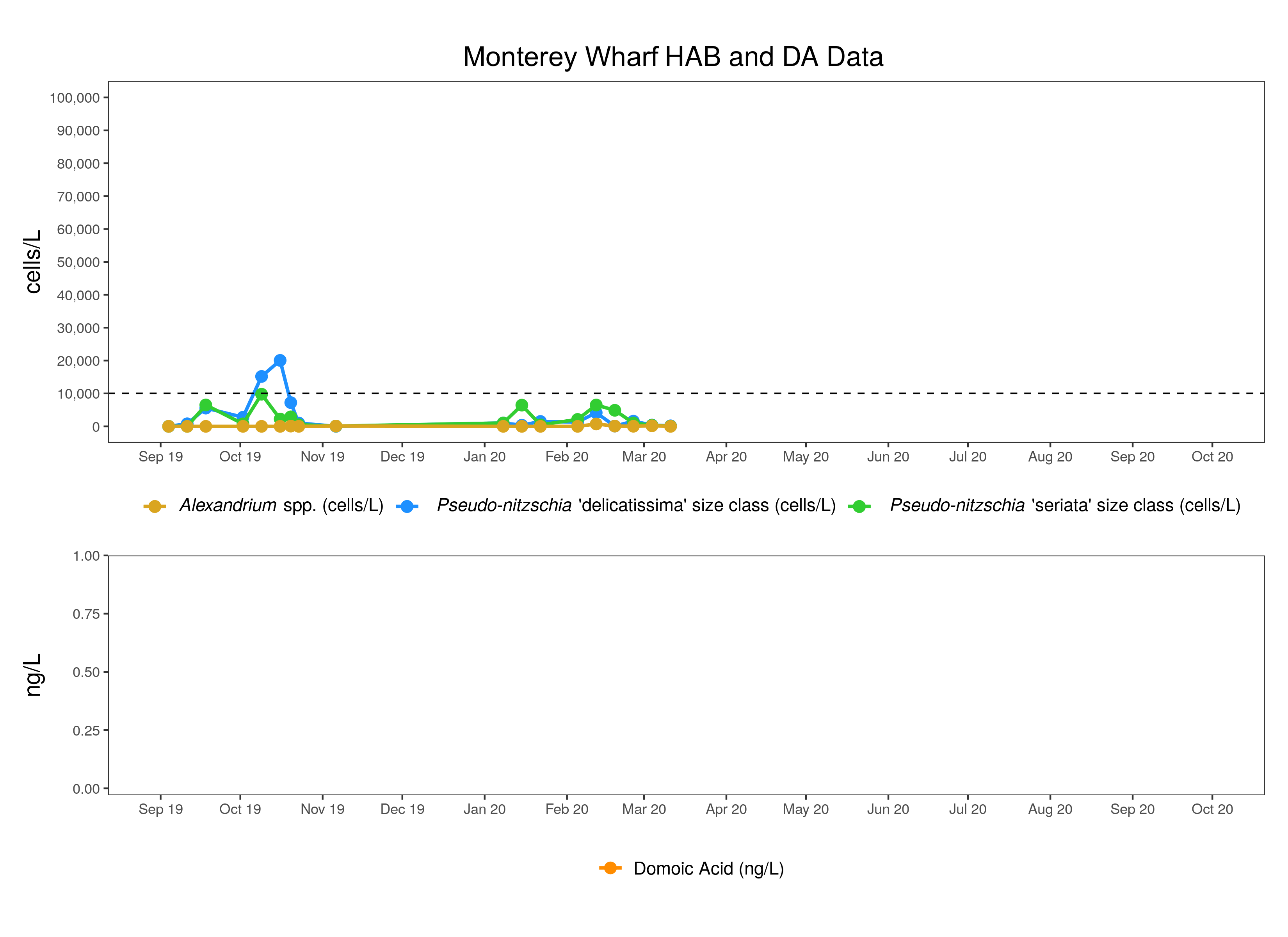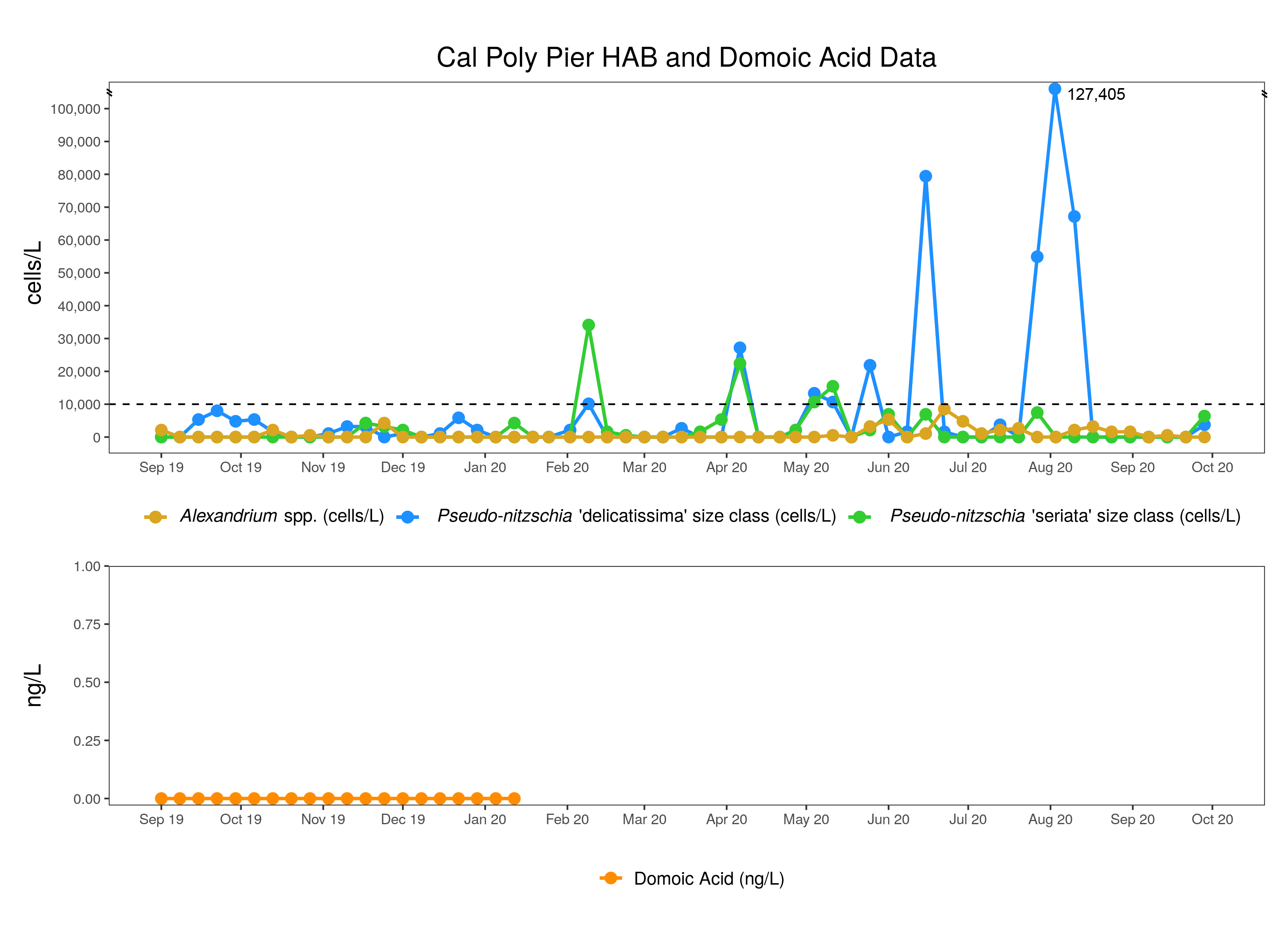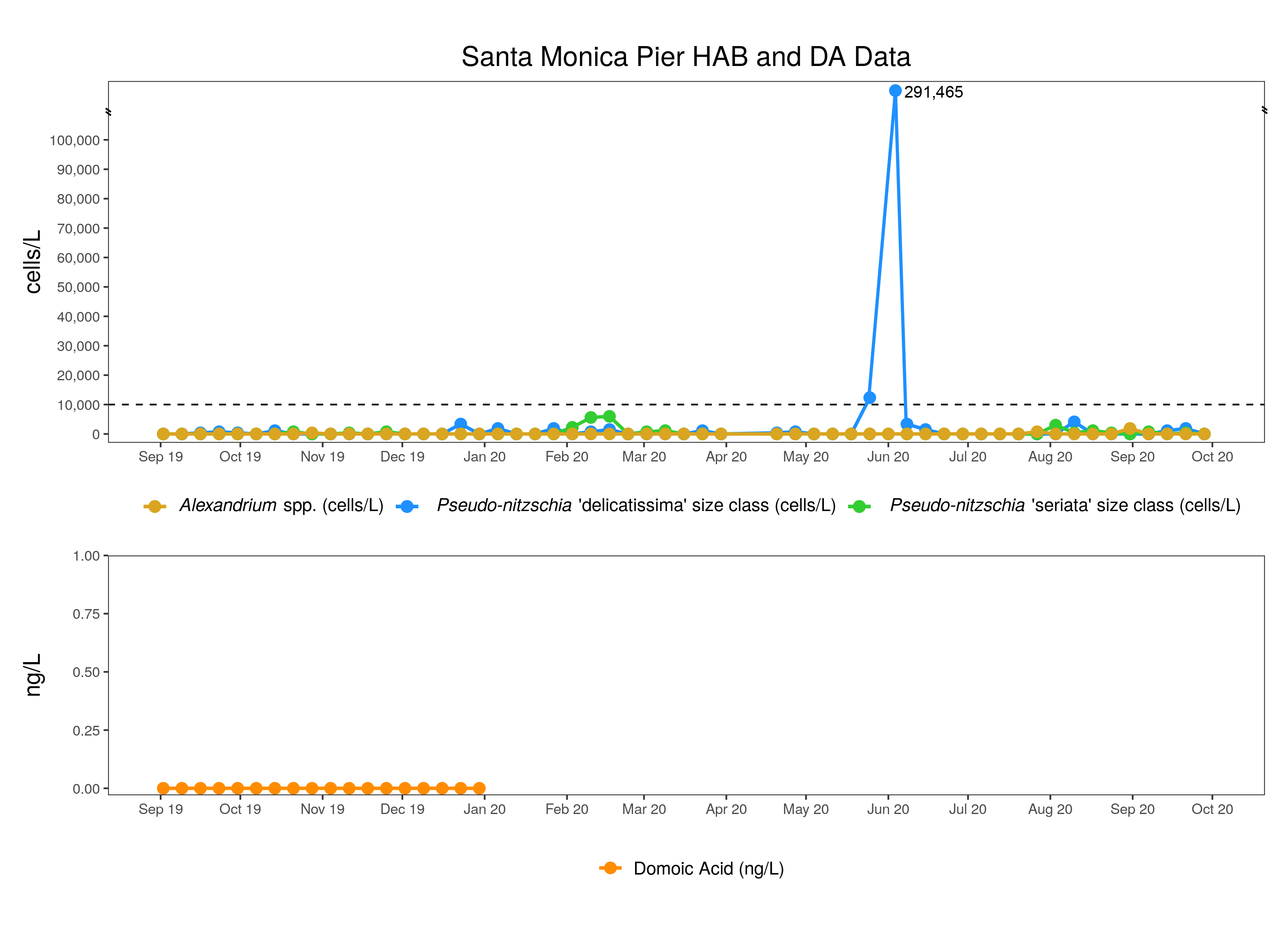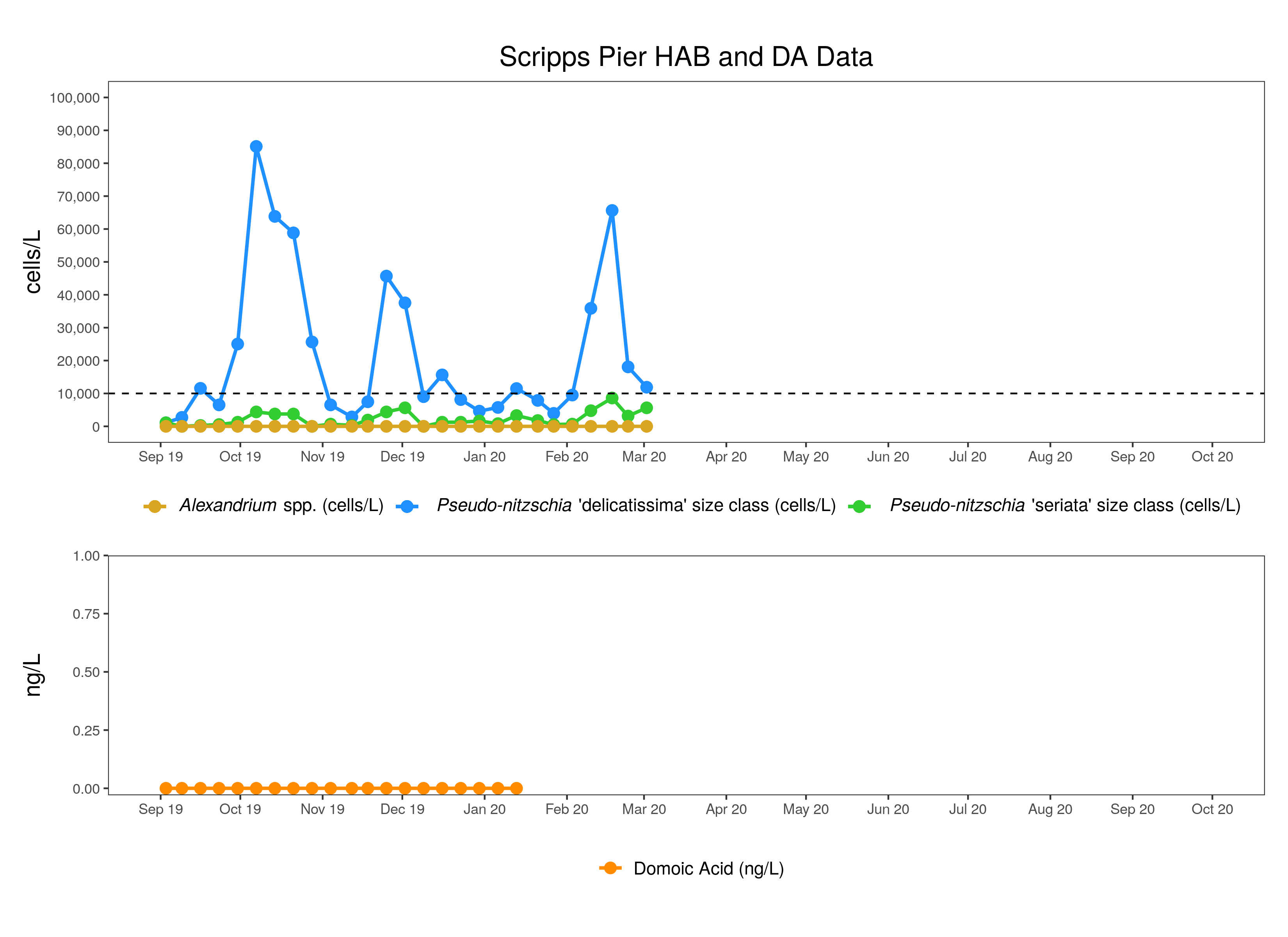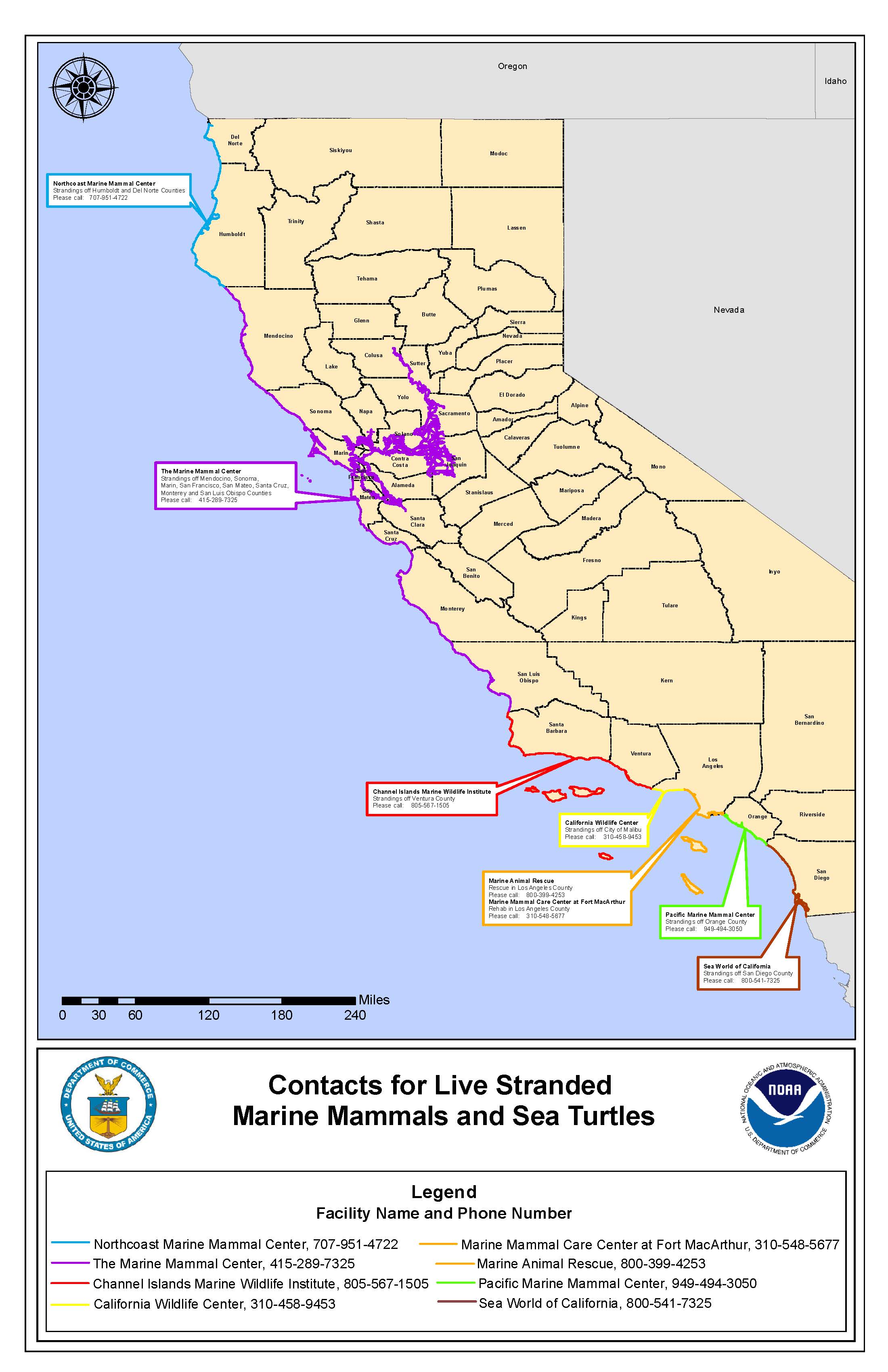Be sure to also read the special Red Tide Bulletin: Spring 2020
Pseudo-nitzschia - C-HARM tells us where conditions are suitable for species of the diatom Pseudo-nitzschia spp. (all size classes) to grow well and where they might be more likely to produce domoic acid (DA). The predicted suitable habitat for Pseudo-nitzschia spp. was spread throughout coastal California from the Santa Barbara Channel to the Oregon border in September, a pattern in the C-HARM model that has persisted but with some nuances each month. This indicates that C-HARM is predicting positive habitat suitability for the genus Pseudo-nitzschia in most parts of coastal California, something that is corroborated by the frequent presence of Pseudo-nitzschia species at our pier sites, albeit not always at bloom levels. In general, most of the coast in September exhibits persistently high bloom probabilities. Local minima in Pseudo-nitzschia bloom probabilities occurred in the 20-50 km nearest the coastline throughout the state at various times in the month, as in August. Bloom probabilities in the Southern California Bight trended high throughout the month, although confined more to the nearshore zone and with high spatial and temporal variability, similar to previous months. While COVID-19 sampling restrictions continue to hamper our ability to acquire HABMAP observations from piers, we do know that the abundance of the toxigenic Pseudo-nitzschia "seriata" size class remained at zero at Santa Cruz Wharf throughout September. This is both consistent and inconsistent with the C-HARM bloom probabilities at the pixel near the SC Wharf since they were highly variable, bouncing between zero and 100% probability for bloom levels of Pseudo-nitzschia spp. At Cal Poly Pier and Stearns wharf, the observed abundance of the both Pseudo-nitzschia size classes showed some uptick in September but never reached bloom levels. The only southern California site where bloom levels were reached was at Newport Beach Pier in Orange County, where the less toxigenic group Pseudo-nitzschia 'delicatissima' exceeded the bloom threshold towards the end of September (noting that data are not yet available for Scripps Pier due to COVID-related delays and personnel challenges). The highest abundances of the Pseudo-nitzschia "seriata" size class recorded by the CDPH were located near San Francisco at Pacifica Pier and near the UC Santa Barbara campus at Goleta Pier.
Moderate to very high probabilities (60-100%) of particulate DA (pDA) were predicted for many parts of the California coast throughout September, maintaining the large offshore extent predicted by C-HARM in previous months. South of the Santa Barbara Channel, pDA was often predicted to exceed the 500 ng/L threshold but with a patchy distribution throughout the Bight, and as with Pseudo-nitzschia predictions, those high probabilities extended far offshore as in August. Probabilities for pDA along the central coast from Carmel to San Luis Obispo County exhibited local minima in the nearshore, sometimes dipping into zero probability of high pDA in the SLO region, a pattern that also was seen for large swaths of the Sonoma, Mendocino, and Humboldt coasts in northern California. While much of the elevated pDA probabilities extended very far offshore, predicted cellular DA (cDA) risk appeared to be contained in a fairly tight nearshore band for much of the coastline and was often, but no consistently, high from northern San Luis Obispo County to the Oregon border for the first half of the month, with local minima and a lot of variability from Sonoma County to the Mexican border. The overall take-away is that cDA probabilities were frequently high along the North and Sonoma Coasts (including areas adjacent to SF Bay), suggesting a possible issue there as seen in August when the North Coast was even more aggressively predicted to be a cDA problem. The frequent and extensive high probabilities for pDA (and cDA) along the central coast and Sonoma County are consistent with the four California Sea Lion strandings from suspected DA toxicosis reported by The Marine Mammal Center (TMMC) from San Mateo, Monterey, and SLO Counties in September; although, note that other regions with high pDA or cDA predictions had no recorded strandings this month. No domoic acid measurements are yet available from HABMAP sampling for September.
Alexandrium - CDPH recorded low or zero Alexandrium spp. at all sites sampled in September, consistent with abundances observed by HABMAP at piers, and in stark contrast to the very high abundances observed in July when Paralytic Shellfish Poisoning warnings were issued but have since been lifted for all counties.
*Please note that HABMAP sampling, CDPH sampling, and marine mammal rescues have been greatly reduced in response to COVID-19 safety measures.
**HABMAP sampling has been suspended since March 19th in accordance with the Governor's stay at home order to protect the health and well-being of all Californians and to help slow the spread of COVID-19. Cal Poly and Scripps received an exception to continue collecting water samples for the State and are taking the necessary safety measures to protect field personnel. The water samples are being preserved for future analysis by the Caron or Kudela Labs for domoic acid and Brzezinski/UCSB Marine Analytical Labs for macronutrients when it is safe for lab personnel to do so.**
Note that data for some stations are not shown because they are not yet recorded in the public HABMAP archive.
Differentiating Pseudo-nitzschia species by light microscopy is difficult. For this reason, Pseudo-nitzschia "seriata" does not refer to an actual species but rather the larger size class of Pseudo-nitzschia, which is generally a more toxigenic group of species. Alternatively, Pseudo-nitzschia "delicatissima" refers to the smaller size class that is generally non-toxigenic. The dashed line on the plots demarcates the 10,000 cells/L "bloom" threshold designated here for Pseudo-nitzschia populations only.
More information and data visualizations on the statewide HAB network and forecasting system can be found on the California HABMAP website and on the SCCOOS Harmful Algal Bloom page.
Santa Cruz Wharf
Water samples were collected at Santa Cruz Wharf 4 times in September. Molecular probes for toxigenic Pseudo-nitzschia in the "seriata" class are conducted for this site, and was not detected during the sampling period. Alexandrium spp. were detected on 15 and 29 of Sept. Domoic acid results are not yet available.
The Santa Cruz Wharf shore station is supported by CeNCOOS PI Raphael Kudela at UCSC.
Monterey Wharf
Water sampling has been suspended at Monterey Wharf since March 2020 in response to COVID-19 safety measures.
Monterey Wharf shore station is supported by CeNCOOS PI's Raphael Kudela at USCS and Jason Smith and Moss Landing Marine Labs.
Cal Poly Pier
Water samples were collected 4 times at Cal Poly Pier in September. Pseudo-nitzschia "delicatissima" and Pseudo-nitzschia "seriata" were detected in only one sample on 28 Sept, below bloom levels. Alexandrium spp. were also detected in 1 sample on 14 Sept. Domoic acid results are not yet available.
Cal Poly Pier shore station is supported by SCCOOS PI Ryan Walter and Ally Pasulka at Cal Poly.
Stearns Wharf
Water samples were collected 3 times at Stearns Wharf Pier in September. Pseudo-nitzschia "delicatissima" and Pseudo-nitzschia "seriata" were present in each water sample but not above bloom levels. Alexandrium spp. were not detected in any water samples. Domoic acid results are not yet available.
Stearns Wharf is supported by SCCOOS PI Mark Brzezinski and Libe Washburn at UCSB.
Santa Monica Pier
Water samples were collected 4 times at Santa Monica Pier in September. Pseudo-nitzschia "delicatissima" was detected on 14 and 21 Sept, below bloom levels. Pseudo-nitzschia "seriata" was detected on 7 and 21 Sept, also below bloom levels. Alexandrium spp. were not detected in any samples and domoic acid results are not yet available.
Santa Monica Pier shore station is supported by SCCOOS PI Rebecca Shipe at UCLA.
Newport Beach Pier
Water samples were collected 4 times at Newport Beach Pier in September. Pseudo-nitzschia "delicatissima" was detected in each sample, but only above bloom thresholds on 14 Sept. Pseudo-nitzschia "seriata" was detected in 3 of the 4 samples, all below bloom levels. Alexandrium spp. were detected only on 14 Sept and domoic acid results are not yet available.
Newport Beach Pier is supported by SCCOOS PI David Caron at USC.
Scripps Pier
Scripps Pier water samples are not yet available for April through September 2020.
Scripps Pier is supported by SCCOOS and PIs Melissa Carter and Clarissa Anderson at UCSD.
CDPH observations for Pseudo-nitzschia 'seriata' and Alexandrium spp.
Please note, starting in July 2019, CDPH moved to only reporting Pseudo-nitzschia of the seriata complex and not all Pseudo-nitzschia spp. as previously provided.
From 1-30 September 2020, water samples were collected by volunteers and sent to the California Department of Public Health (CDPH) for analysis. Pseudo-nitzschia 'seriata' group was detected in 37 of the 89 samples. Pseudo-nitzschia 'seriata' was detected at "Common" density levels (using CDPH relative abundance index) on September 1 at Pacifica Pier (12% composition) and at Goleta Pier on September 2 (12% composition). Alexandrium spp. were detected in 20 of the 89 samples in the month of September. Alexandrium spp. were detected at "Present" density levels or below.
You can view an interactive map and data table of CDPH data from January 2019 to present developed by SCCOOS below or you can also view CDPH Toxic Phytoplankton Observations Map with layers of Pseudo-nitzschia and Alexandrium spp. as well as other phytoplankton species observations (in the pop-up windows).
Data are provided by the California Department of Public Health, Environmental Management Branch.
CDPH and OEHHA Health Advisories
California Department of Public Health (CDPH) annual quarantine of sport-harvest mussels began May 1, 2020. The quarantine is in place to protect the public against poisoning that can lead to serious illness, including coma and death.
On July 1st, CDPH advised consumers not to eat sport-harvested mussels, clams, or whole scallops from San Francisco, San Mateo, Santa Cruz, and Monterey counties. Dangerous levels of paralytic shellfish poisoning (PSP) toxins have been detected in mussels from those four counties. The naturally occurring PSP toxins can cause illness or death in humans.
UPDATE: CDPH lifted the safety notification for sport-harvested clams and whole scallops in San Francisco and San Mateo counties on September 1 and for Santa Cruz and Monterey counties On September 29.
For the latest closures and updates, please visit the CDPH Health Advisories page as a central location of information related to CDPH health advisories. Also available is a map showing the current CDPH Recreational Bivalve Shellfish Advisories (see below).
NEWS: The HAB-related illness workgroup has developed a new webpage for marine HAB-related illness tracking work (https://oehha.ca.gov/fish/general-info/marine-harmful-algal-bloom-hab-related-illness-tracking).
California Marine Mammal and Seabird Strandings from Suspected DA Toxicosis
Domoic acid (DA) is a potent neurotoxin produced by some diatom species of the genus Pseudo-nitzschia. Species exposed to DA can result in seizures, epilepsy, cardiomyopathy, and death depending upon the ingested dose. DA toxicosis commonly occurs in California Sea Lions (Zalophus californianus), presumably due to a combination of foraging behavior and seasonal movements. The Marine Mammal Center (TMMC), Channel Islands Marine Wildlife Institute (CIMWI), California Wildlife Center (CWC), Marine Mammal Care Center Los Angeles (MMCC-LA), Marine Animal Rescue (MAR), the Pacific Marine Mammal Center (PMMC), and SeaWorld act like an emergency room by working to rescue and rehabilitate sick and injured marine mammals, seabirds, and sea turtles.
Among the seven rehabilitation centers we received data for in the month of September 4 marine mammal stranding presented with symptoms of domoic acid toxicosis.
The Channel Islands Marine Wildlife Institute (CIMWI), California Wildlife Center (CWC), Marine Mammal Care Center Los Angeles (MMCC-LA), Pacific Marine Mammal Center (PMMC) and SeaWorld did not record any strandings due to suspected domoic acid in September 2020.
September strandings due to suspected DA toxicosis occurred in the following counties:
- Sonoma (TMMC)
- September 24 - adult, female, Northern Fur Seal
- San Luis Obispo (TMMC)
- September 1 - subadult, female, California Sea Lion
- September 17 - adult, female, California Sea Lion
- Monterey (TMMC)
- September 12 - adult, female, California Sea Lion

